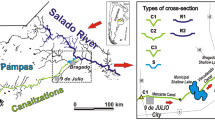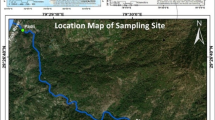Abstract
Changes in the density of 2 populations of Bosmina longirostris, Holopedium gibberum and Codonella cratera were correlated through multiple regression analyses with shifts in temperature, light, nannoplankton densities and seston weight. Sampling took place every 2 weeks between June 1975 and November 1976 in the Yellowknife River and Yellowknife Bay, both in the Canadian subarctic. Temperature was usually the main factor influencing all 3 species, accounting for up to 60% of the seasonal variability in B. longirostris, 37% in H. gibberum and 62% in Codonella cratera. Seston (the major food source) ranked second overall and in one instance accounted for 60% of density changes in B. longirostris. Nannoplankton were consumed in only small numbers and had little influence on densities. Light was of minor importance to all species. Temperature was also the main factor effecting reproduction and feeding in B. longirostris and H. gibberum (the only species studied). The simultaneous collections of Ceratium hirundinella made in the river and bay indicated that temperature accounted for 30–55% of the seasonal variability of this species, followed by light (4% and nutrients (3–4%).
Similar content being viewed by others
References
Allan, J. D. 1972. Competition and the relative abundance of two cladocerans. Ecology, 54: 484–498.
Bhajan, W. R. & Hynes, H. B. N. 1972. Experimental study on the ecology of Bosmina longirostris (O. F. Müller) (Cladocera). Crustaceana, 23: 133–140.
Bottrell, H. H. 1975. The relationship between temperature and duration of egg development in some epiphytic Cladocera and Copepoda from the River Thames, Reading, with a discussion of temperature functions. Oecologia, 18: 63–84.
Burns, C. W. 1968. The relationship between body size of filter-feeding Cladocera and the maximum size of particle ingested. Limnol. Oceanogr. 13: 675–678.
Chandler, D. C. 1940. Limnological studies of western Lake Erie. I. Plankton and certain physical-chemical data on the Bass Islands region, from September, 1938, to November, 1939. Ohio J. Sci. 40: 291–336.
Chisholm, S. W., Stross, R. G. & Nobbs, P. A. 1975. Environmental and intrinsic control of filtering and feeding rates in Arctic Daphnia. J. Fish. Res. Bd Can. 32: 219–226.
Clark, A. S. & Carter, J. C. H. 1974. Population dynamics of cladocerans in Sunfish Lake, Ontario. Can. J. Zool. 52: 1235–1242.
Edmondson, W. T. 1955. The seasonal life history of Daphnia in an arctic lake. Ecology, 36: 439–455.
Fryer, G. 1957. The food of some freshwater cyclopoid copepods and its ecological significance. J. Anim. Ecol. 26: 263–286.
Gold, K. 1968. Some observations on the biology of Tintinnopsis sp. J. Protozool. 15: 193–194.
Goulder, R. 1976. The tintinnid protozoon Codonella cratera (Leidy) in two gravelpit ponds. Arch. Hydrobiol. 77: 403–410.
Hall, D. J. 1964. An experimental approach to the dynamics of a natural population of Daphnia galeata mendotae. Ecology, 45: 94–112.
Hutchinson, G. E. 1967. A treatise on limnology, Vol. Wiley, New York.
Kimor, B. 1969. The occurrence of some tintinnid protozoans in the plankton of Lake Tiberias. Verh. int. Verein. theor. angew. Limnol. 17: 358–361.
McMahon, J. W. 1965. Some physical factors influencing the feeding behaviour of Daphnia magna Straus. Can. J. Zool. 43: 603–611.
Moore, J. W. 1976. Seasonal succession of algae in rivers. I. Examples from the Avon, a large-slow-flowing river. J. Phycol. 12: 342–349.
Moore, J. W. In press. Ecology of subarctic populations of Cyclops bicuspidatus thomasi Forbes and Diaptomus ashlandi Marsh. Crustaceana.
Moore, J. W. 1977. Relative availability and utilization of algae in two subarctic streams. Hydrobiologia 54: 201–209.
Schindler, D. W. 1969. Two useful devices for vertical plankton and water sampling. J. Fish. Res. Bd Can. 26: 1948–1972.
Smyly, W. J. P. & Collins, V. G. 1975. The influence of microbial food sources and aeration on the growth of Ceriodaphnia quadrangula (O. F. Müller) (Crustacea: Cladocera) under experimental conditions. Freshwat. Biol. 5: 251–256.
Sprules, W. G. 1972. Effects of size-selective predation and food competition on high altitude zooplankton communities. Ecology, 53: 375–386.
Stross, R. G. & Kangas, D. A. 1969. The reproductive cycle of Daphnia in an arctic pool. Ecology, 50: 457–460.
Weglenska, T. 1971. The influence of various concentrations of natural food on the development, fecundity and production of planktonic crustacean filtrators. Ekol. Polska, 19: 426–473.
Wright, J. C. 1965. The population dynamics and production of Daphnia in Canyon Ferry Reservoir, Montana. Limnol. Oceanogr. 10: 583–590.
Author information
Authors and Affiliations
Rights and permissions
About this article
Cite this article
Moore, J.W. Some factors influencing the density of subarctic populations of Bosmina longirostris, Holopedium gibberum, Codonella cratera and Ceratium hirundinella. Hydrobiologia 56, 199–207 (1977). https://doi.org/10.1007/BF00017506
Received:
Published:
Issue Date:
DOI: https://doi.org/10.1007/BF00017506




